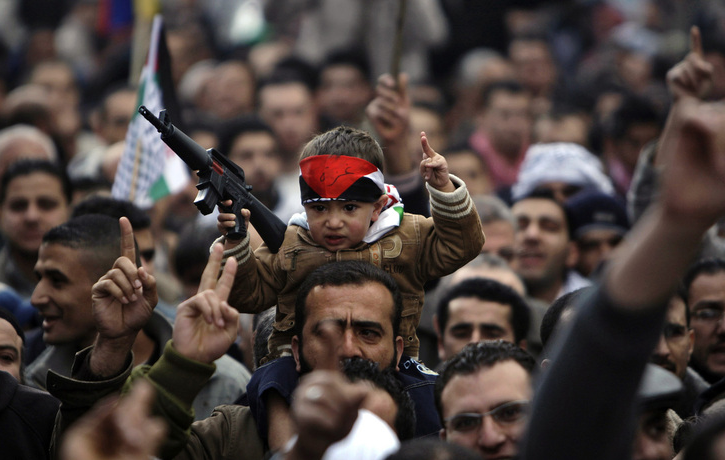The image of Palestinian children (as well as Iraqi children) with “toy guns” has become such a cliché in recent times that I’ve almost stopped paying attention to them when they show up in journalistic slideshows. But the photograph below, which appeared recently on the Washington Post website, warrants a close look despite what might seem initially as a weary stereotype.
What distinguishes this image from the many others in the “toy gun” genre is that the young boy is not with other children playing with his fake weapon, nor is he being watched over by a small group of approving adults. Rather, he is part of what appears to be a fairly large crowd of men raising their hands in protest, and notwithstanding the gaze of the camera, he does not receive any special attention from his fellow Palestinians. He is simply one among many. And from this perspective, it is not so much the toy gun that stands out in the picture (a marker of his childhood), but rather his left hand raised in protest and civic solidarity (a harbinger of his impending adulthood).
What we are witnessing, in short, is the process of political socialization. There is nothing all that surprising about the young boy’s gesture as he imitates his elders, nor would it be all that troubling but for the historical and geo-political contexts in which it occurs. But therein lies the rub. For what the image depicts is not just the coming of age of a new citizen—Palestinian or Israeli, it really doesn’t matter—but the guaranteed perpetuation of the current crisis as each subsequent generation is sucked up within an extended, perverse, and inexorable vortex of hatred and fear that has become normative.
The conflict between Israelis and Palestinians has been going on for so long, and there have been so many dips and turns, that I truly don’t know where the blame resides, though my strong suspicion is that there is plenty to go around and that there are few parties—if any—who are altogether blameless. And I don’t know what the solution is as long as each of the many sides remains stubbornly entrenched in its positions and oppositions. But the photograph above makes me want to weep as I imagine the many future generations consigned to the same culture of violence and suffering animated ultimately by their own diplomatic incompetencies. Surely there is a better way.
Photo Credit: Eliana Aponte/Reuters

I appreciate your close reading of this photograph but I find your conclusion to be much too general and sweeping, which is exactly what this sort of stereotyped image encourages. I am sure there are many Palestinian (and Israeli) children who will grow up to fear and hate the other due to the inexcusable inability of political leaders to fashion a just settlement. But as in any other society there are many who will experience trauma and come out of it with a desire for healing and reconciliation. There are many ordinary Palestinians who have lived through dispossession in 1948 or military occupation since 1967, for example, who are actively working for peace in civil society organizations, NGOs, and groups that reach out to Israelis. Many more are serving their communities peacefully as doctors, educators, lawyers, artists, businesspeople and on and on. These people are often overlooked and rarely depicted in photographs so that the general impression of the Palestinian people is that of generations “consigned to the same culture of violence and suffering,” as if there is no diversity, no complexity. Neither Palestinian nor Israeli society is wholly consumed in an “extended, perverse, and inexorable vortex of hatred and fear that has become normative.” Anyhow, I agree that something must change, primarily on the geopolitical level. In the meantime I wish that the representation of Palestinian society and experience could be expanded beyond the tropes of violence, fear and suffering.
MIchelle: I appreciate your point and I hope you are right (though I have to admit that I am skeptical). BUT you misunderstood my point. What I’m describing is what the picture depicts. This young boy might end up working for an NGO or advocating non-violence, but that’s not what the picture tells me. What you describe … well, to be honest, I’ve not seen that photograph. It might be because photography is not up to that task, or maybe there is no interest in showing that picture, or … or … BUT that image simply isn’t there. Perhaps that’s part of the problem.
for me, it’s like: how can you talk peace if you have a gun?
given that the young boy flashes a peace sign, too. it depends how one understands and interprets a certain image. it could also mean: they believe that peace could only be achieved through the barrel of the gun.
just my own opinion. thanks